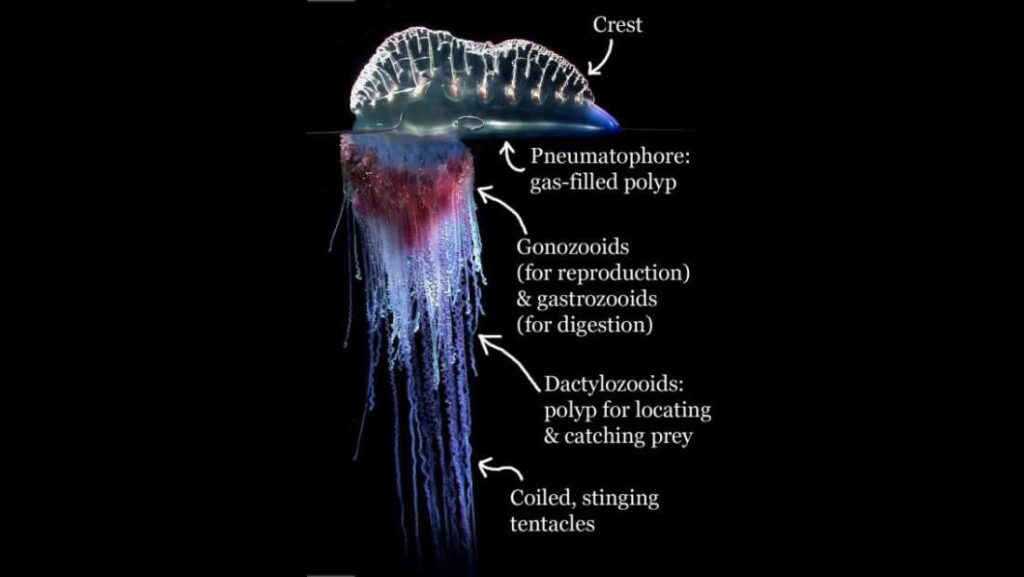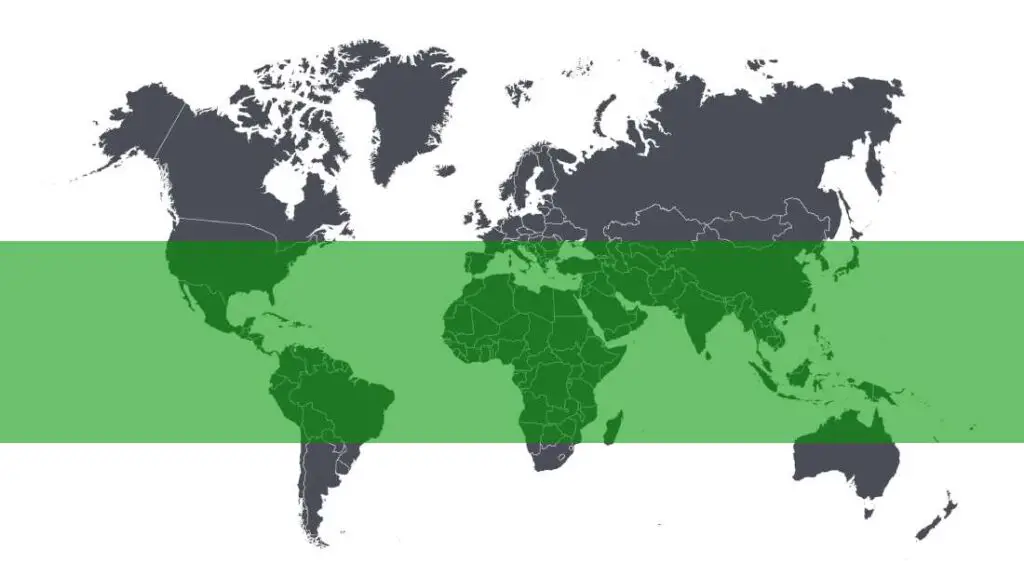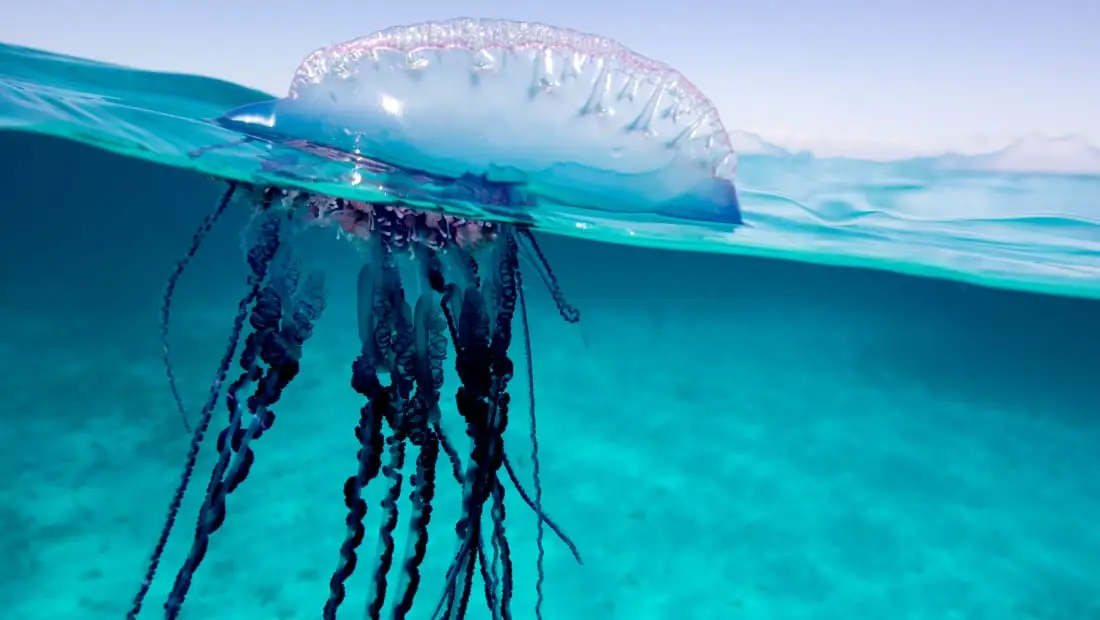Overview
the Portuguese man o’ war also known by its binomial name Physalia physalis. It is usually mistaken for a jellyfish, but it actually belongs to a species of siphonophore, a group of animals that are closely related to jellyfish.
The name Portuguese man o’ war springs from the uppermost popular polyp, a gas filled bladder (pneumatophore), which floats above the water and eventually looks like an old eighteenth-century sailing ship used for wars.
They’re also mentioned as bluebottles due to the purple-blue colour of their pneumatophores. It’s a marine hydrozoan found in the tropical and subtropical marine waters (Atlantic & Indian ocean).
The Portuguese man o’ war comprises of four separate polyps.It gets its name from the uppermost polyp, a gas filled bladder, or pneumatophore, which stays afloat above the surface of water and eventually resembles an old warship at full sail.
Its long tentacles are its second organism. It can extend to 165 feet but on an average the are around 30 feet in length. These tentacles may not look dangerous but they are covered with venom filled nematocysts which it uses to paralyse its prey, mainly fish and other small small creatures.
Each tentacle contains tiny thread-like structures called nematocysts. Upon contact with the prey these Nematocysts get triggered and inject venom into its prey.
Once the prey is unable to move the contraction of the tentacles drag the prey upwards to the gastrozooids and finally The gastrozooids surround and digest the food by secreting enzymes.
its sting is extremely painful for humans and very rarely could be deadly. Even after it’s death or detachment from its body the venom can still remain potent for hours or sometimes even days.
Once a human is stung it causes severe pain and leaves a whip like red mark on the area which can remain for two to three days.
Anatomy of Portuguese Man O’ War

The Portuguese man o’ war is a siphonophore which means it is composed of two or more conspecific individuals (known as zooids) living in close association with, or connected to, one another. This very association helps the organism to either defend themselves or give them the ability to attack a prey.
The man-of-war comprises four separate polyps the uppermost polyp or the float from which it gets its name is made up of two nested containers, an outer muscular case with a sail-like crest and an inner air bladder which help it to stay afloat and travel long distances.
The second polyp are its long venomous tentacles that bears tiny, coiled, thread-like structures called nematocysts which inject venom into the prey on contact killing or paralysing its prey.
The muscles in the tentacles contract and real the prey up towards its third polyp that is it’s digestive organisms or the gastrozooids
The fourth Poly are its reproductive organisms called the gonophores, as the Portuguese man o’ war are dioecious meaning each colony can either be male or female, Gonophores producing either sperm or eggs.
Habitat Of Portuguese Man O’ War

Portuguese man o’ war are most often found in warm, tropical and subtropical marine waters but can be found in the Indian Ocean, Pacific Ocean, Atlantic Ocean, and the Caribbean. They can cover long distance by drifting on the currents or in the strong winds.
Lifespan & Reproduction
Depending on favorable condition the average Portuguese man o’ war lives for at least one year.
Reproduction takes place during the autumn season. As the man o’ war is dioecious i.e. a colony can be either male or female. The reproductive organ called the Gonophores sits on a tree like structure called the gonodendron which drops off from the colony during reproduction.
During Autumn Mating takes place and the eggs or sperm depending on the gender of the organism shed from gonophores into the water. Direct observation of the fertilization has not been directly observed in the wild yet, therefore it is not clear the depth in witch they occur
Food & Diet
Portuguese man o’ war diet consists of small fish, plankton, worms, crustaceans and other small animals. When ever an unlucky prey comes in contact with any of its tentacles they shoots its nematocysts and injects venom into the prey killing or paralysing it and finally pulls it up to its gastrozooid polyp which are located along the underside of the float.
These gastrozooids surround the prey and secrete digestive enzymes that break down fats, protein and carbohydrates. Any undigested remains is then pushed out.
Portuguese man o’ war facts and Questions
1. Portuguese man o’ war size
The float itself can be up to 6 inches (15 cm) tall and its tentacles can grow as long as 165 feet (50 m)
2. Where does the name Portuguese man o’ war come from?
The name Portuguese man o’ war comes from the the gas filled bladder (pneumatophore), which floats above the water and closely resembles an old sailing warship
3. Sea Slugs Like To Steal Their Toxins
The blue dragon a sea slug is one of the predators of Portuguese man o’ war, after kill it the slug stores stinging
nematocysts from the siphonophores within its own tissues as defence against predators.
4. Every Colony Has a Specific sex
Man o’ war individuals are dioecious which means each colony is either male or female. The main reproductive zooids, the gonophores, are situated on branching structures called gonodendra. Gonophores produce sperm or eggs based on its gender.
5. It’s is not a Jellyfish.
The Portuguese man o’ war is often called a jellyfish, but is actually a species of siphonophore, a group of animals that are closely related to a jellyfish.
Conclusion
The Portuguese man o’ war is a marine hydrozoan also know as the floating terror due to it floating upper gas filled bladder and venomous tentacles. Portuguese man o’ war is a colonial organism, made up of many smaller units called zooids.
The scientific name for it is Physalia physalis and is found mainly in warm, tropical and subtropical waters but can travel long distances to other places as well. It feeds on small fish, plankton, worms, crustaceans and other small animals.
They are know to sting humans as well which causes severe pain and could be fatal at times. Some fishes also use the tentacles as shelter.


It was a great and useful article
Thanks a lot, It really motivates us to do much better.